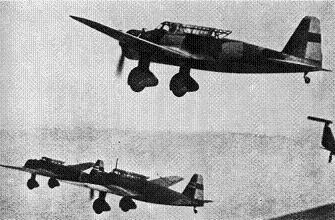![]() The Pacific War Online Encyclopedia
The Pacific War Online Encyclopedia
|
| Previous: Liberty Tankers | Table of Contents | Next: Light Carriers (CVL) |

U.S. Navy. Via Francillon (1979)
Light bombers
carried a relatively light bomb load
but were suitable for tactical
missions requiring rapid response and flexibility. Most were single
engine aircraft with a
crew of two or three. Dive
bombers specialized in accurate attacks with bombs
against high-valued land or naval targets. Torpedo
bombers, as the name
implies, were naval aircraft specializing in delivering torpedoes against shipping, but
they could also be employed as horizontal bombers against ground
targets. A few light bombers, particularly in Japanese service, were
capable neither of carrying torpedoes nor of maintaining the steep
dives characteristic of dive bombers. These are listed below.
References
The Pacific War Online Encyclopedia © 2009-2010 by Kent G. Budge. Index